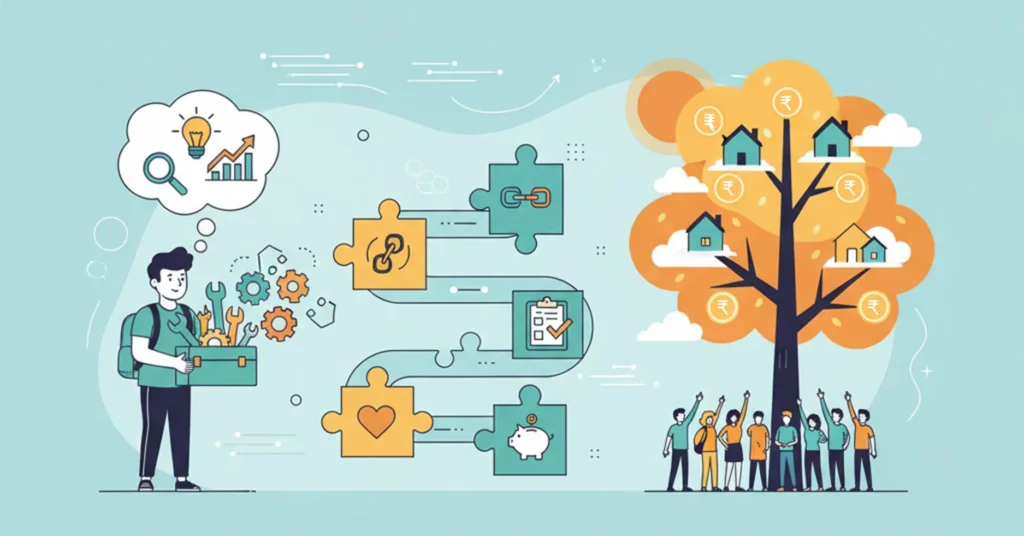How to Get a High-Paying Career in Data Analytics

Hello, students! Are you thinking about a career in data analytics?
Data analytics is a fast-growing field. It offers many exciting opportunities.
This guide will help you understand everything about data analytics.
We will cover skills, career paths, and free resources.
Learn the skills that top companies are hiring for—no experience needed!
Table of Contents
ToggleWhat is Data Analytics Training?
Data analytics helps us understand information. It turns raw numbers into useful knowledge. Think of it like finding hidden stories in numbers.
Simple Definition for Students
Data analytics is simply the process of examining data to find patterns. We then use these patterns to make better decisions. It helps businesses understand their customers, improve products, and solve problems.
Why Data Analytics is Gaining Popularity
Today, we create a huge amount of data every second. Businesses want to use this data to grow. This is why data analytics is becoming very popular. Companies need people who can make sense of this data.
Real-World Applications of Data Analytics
Data analytics is everywhere! For example:
- Online Shopping: Companies like Amazon use it to suggest products you might like.
- Banking: Banks use it to detect fraud and keep your money safe.
- Healthcare: Hospitals use it to improve patient care and understand diseases.
- Sports: Teams use it to analyze player performance and improve game strategies.
Who Should Learn Data Analytics?
Many students wonder if data analytics is for them. The good news is, it’s open to almost everyone!
Can Non-Technical Students Learn It?
Absolutely, yes! You do not need a strong technical background to start. Data analytics is more about clear thinking. You must also ask the right questions. Many successful data analysts come from diverse fields. These include business, accounting, or marketing. The technical skills are learnable, step by step.
Ideal Backgrounds – BCA, B.Com, B.Sc, Engineering, etc.
Students from many backgrounds can learn data analytics. For example, those with degrees in:
- BCA / B.Sc (IT/Computer Science): You already have a strong base.
- B.Com / BBA: You understand business. This is very helpful in data analytics.
- Engineering: Your problem-solving skills are a great asset.
- Mathematics / Statistics: You have a natural advantage.
Even if your degree is different, you can still succeed!
Common Fears Students Have (and the Reality)
Many students have some common fears:
- “I am not good at math.” Reality: You need basic statistics. You do not need very advanced math for most roles.
- “Coding is too hard.” Reality: You will learn practical coding. Tools like Python are quite user-friendly.
- “It is only for tech geniuses.” Reality: It is for anyone who loves solving puzzles and thinking logically.
Your dream analytics career starts with one click—take the first step now!
Why is Data Analytics Important for Your Career?
Choosing data analytics can be a smart move for your future. The demand is high, and salaries are attractive.
Job Market Demand (2025 and Beyond)
The demand for data analysts is growing rapidly. Businesses are becoming more data-driven. This means more job openings in various industries. In India, digital growth is boosting this demand even more. Data analyst is a stable career choice.
Salaries of Data Analysts vs Data Scientists
Both roles offer good salaries, but they differ:
- Data Analyst: For freshers, average starting salaries in India are around ₹4-7 LPA. This can increase with experience.
- Data Scientist: These roles often require more advanced skills and degrees. Therefore, their starting salaries are typically higher, around ₹6-12 LPA for freshers.
Remember, salaries depend on skills, company, and location.
Industries Hiring Data Analysts
Almost every industry needs data analysts today. Here are some key sectors:
IT & Software
These companies produce and manage huge amounts of data. They need analysts to improve products and user experience.
Finance & Banking
Banks use data analytics for fraud detection. They also analyze market trends and manage risks.
Healthcare & Pharma
This sector uses data to improve patient care. They also analyze drug effectiveness and manage hospital operations.
E-commerce & Marketing
Online shopping companies use data to understand customer behavior. Marketers use it to create targeted ads.
What Will You Learn in Data Analytics Training?
A good data analytics course covers both tools and concepts.
Detailed Data Analytics Course Syllabus
Here’s what you will typically learn:
Excel & Spreadsheets
You will learn to organize and clean data. You will also use formulas and create basic charts. Excel is a fundamental tool for data analysis.
SQL & Databases
SQL (Structured Query Language) helps you work with large datasets. You will learn to extract, filter, and manage data from databases.
Data Visualization (Power BI/Tableau)
These tools help you create visuals. You can make charts, graphs, and interactive dashboards. This helps explain complex data easily.
Python for Analytics
Python is a powerful programming language. You will learn to use libraries like Pandas for data manipulation. Matplotlib and Seaborn help with visualization.
Case Studies & Mini Projects
You will work on real-world problems. This helps you apply what you learn. Projects are crucial for building your portfolio.
Tools Covered in a Standard Course
A typical course will cover:
- Microsoft Excel: For basic data tasks.
- SQL (e.g., MySQL, PostgreSQL): For database management.
- Power BI or Tableau: For creating reports and dashboards.
- Python: With libraries like Pandas, NumPy, Matplotlib, and Seaborn.
Top Skills Required to Become a Data Analyst
Becoming a data analyst needs a mix of technical and soft skills.
Technical Skills
These are the core skills for working with data:
Data Cleaning & Preprocessing
Raw data is often messy. You must learn to clean it. This means handling missing values or correcting errors. Clean data gives accurate insights.
Statistics & Probability Basics
You need to understand basic statistical concepts. This includes averages, percentages, and understanding data distributions. This helps you interpret data correctly.
Soft Skills
These skills help you succeed in any job:
Problem Solving
You must be able to break down problems. Then, you use data to find solutions. This is a key skill for any analyst.
Communication & Presentation
You will explain complex data to others. These people might not understand technical terms. So, you must communicate clearly. Good presentation skills are vital.
Start your journey to a high-demand career in Data Analytics today!
Data Analyst vs Data Scientist – What’s the Difference?
Many students confuse these roles. They are related but different.
Roles and Responsibilities
- Data Analyst: Focuses on what happened in the past. They clean data, create reports, and find trends. They answer specific business questions.
- Data Scientist: Focuses on what will happen in the future. They build predictive models and use advanced machine learning. They often work on more complex, open-ended problems.
Skills Comparison
- Data Analyst: Strong in Excel, SQL, and visualization tools. They also need good communication.
- Data Scientist: Needs stronger programming skills (Python/R), advanced statistics, and machine learning knowledge.
Salary and Career Growth
Generally, data scientists earn more due to advanced skills. Both roles have excellent growth potential. A data analyst can become a senior analyst, a business intelligence specialist, or even move into data science with more learning.
Which One is Better for You as a Student?
For most students starting out, a Data Analyst role is a great first step. It helps you build a strong foundation. You can always upskill later to become a data scientist.
How to Start Your Data Analytics Journey as a Student
Start your journey with clear steps. Consistency is important.
Step-by-Step Guide
Follow these steps to begin:
Step 1 – Learn the Basics of Excel and Data Types
Start with Excel. Understand how to manage data in spreadsheets. Learn about different data types (numbers, text, dates). This is your foundation.
Step 2 – Practice with SQL & Databases
Next, learn SQL. Practice querying databases. This helps you access and prepare large datasets efficiently.
Step 3 – Start Visualizing with Power BI
Once you have data, visualize it. Use tools like Power BI to create charts and dashboards. This makes your findings easy to understand.
Step 4 – Learn Python for Analytics
Then, learn Python. Focus on libraries like Pandas for data manipulation. Also, use Matplotlib and Seaborn for more advanced visualizations.
Step 5 – Work on Mini Projects or Internships
Apply your skills! Work on small projects using free datasets. Consider internships. Practical experience is very valuable.
Best Free Resources to Learn Data Analytics
You don’t need to spend a lot to start learning. Many free resources are available.
YouTube Channels
Many channels offer free tutorials. Search for “Data Analytics for Beginners” or “SQL Tutorial”. Look for channels that explain things simply.
Free Courses (Google, Coursera, etc.)
Platforms like Coursera and Google offer free courses or audits. The Google Data Analytics Professional Certificate is a popular option. It covers many essential skills.
Free Datasets for Practice
Websites like Kaggle offer many free datasets. You can download these and practice your skills. Choose topics you find interesting.
Open-Source Tools You Can Try
You can use free tools. Python is open-source. PostgreSQL is a free database system. Power BI Desktop is also free to download and use.
Is Data Analytics Training Worth It in 2025?
Yes, absolutely! Data analytics remains a highly valuable skill set in 2025.
Career Stability & Global Opportunities
The need for data analysis is constant. This gives you good job stability. Data skills are also in demand worldwide. You will find opportunities globally.
High Salary Potential for Freshers
Even as a fresher, you can expect competitive salaries. As you gain experience and skills, your earning potential increases significantly.
Job-Oriented Certifications That Matter
Certifications like the Google Data Analytics Professional Certificate are valued. They show employers that you have the necessary skills. Focus on practical, job-oriented certifications.
Final Advice for Students Who Feel Confused
It’s normal to feel confused at the start. Here are some tips.
Start Small, Be Consistent
Don’t try to learn everything at once. Pick one tool or concept. Learn it well. Practice regularly. Small, consistent efforts lead to big results.
Choose Practical Training Over Theory
Focus on hands-on learning. Theory is important, but applying it is key. Work on projects and solve real problems.
Build Projects, Not Just Certificates
Certificates show you completed a course. Projects show you can do the work. Build a portfolio of projects. This will help you get a job.
Conclusion: Your Journey into Data Analytics Begins Today
Data analytics offers a bright future. It is a field with high demand and great earning potential. Do not let fear stop you. Start learning today. Take small steps. Be consistent.
What are your thoughts or doubts? Share them in the comments below!
FAQ's about Data Analytics Training
Yes, you can learn the basics in about 3 months. However, becoming truly skilled takes more practice. Consistent learning is important.
Start with Excel and SQL. They are fundamental. Then, move to a visualization tool like Power BI. After that, learn Python.
You need basic statistics and probability. You do not need very advanced math like calculus or complex algebra for most data analyst roles.
For basic tasks, no. But for handling large data and doing advanced analysis, yes, coding is very useful. Python and SQL are the most common languages.





